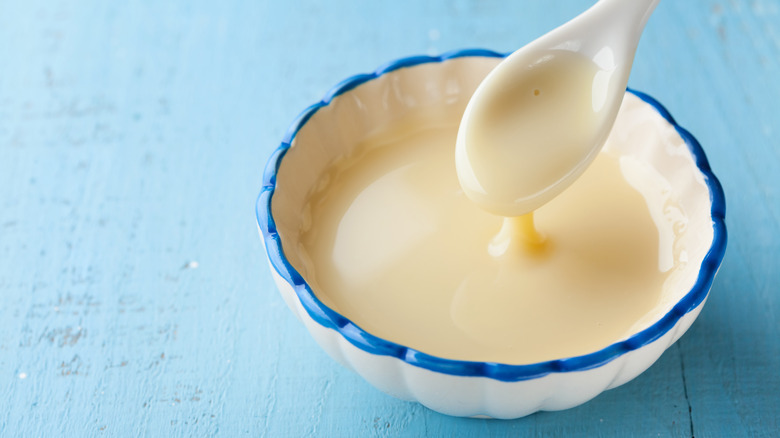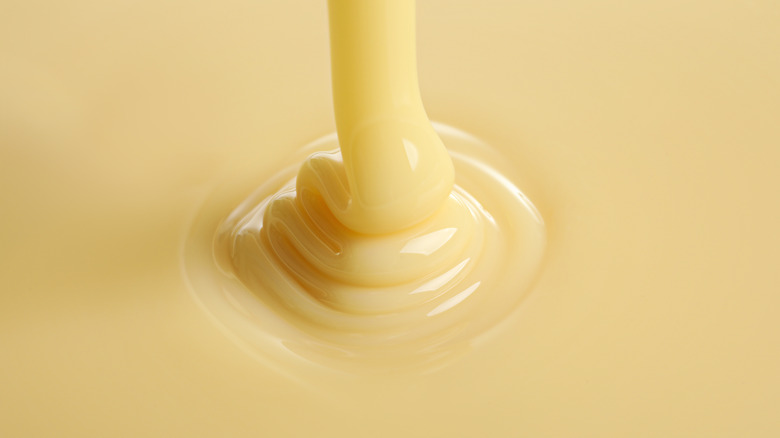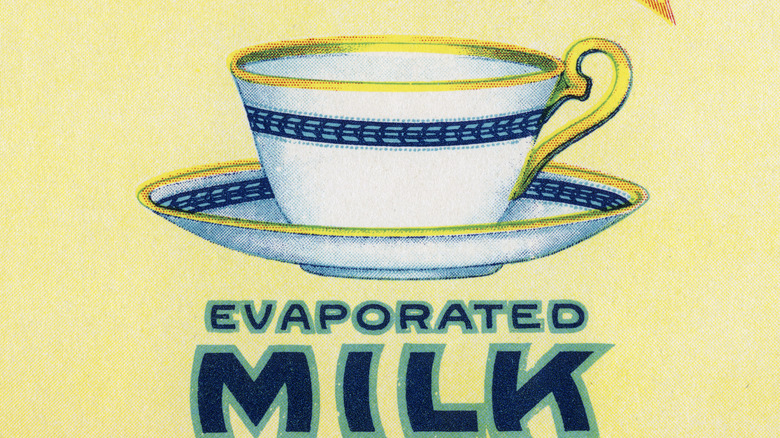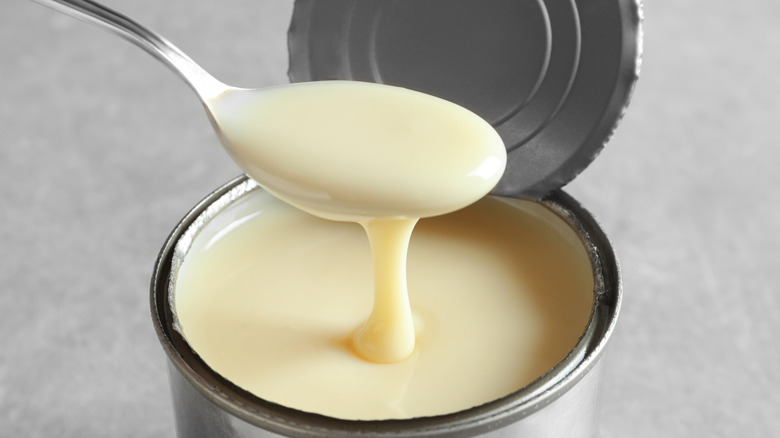What Is Evaporated Milk And Is It Nutritious?
A staple for some, evaporated milk — not to be confused with condensed milk — has a pretty inherently dichotomous name. Of course, entirely evaporated milk would be ... air? So it's safe to say that evaporated milk is plain milk which just so happens to have a high portion of it evaporated, reducing the consistency from a thin, milk-y texture to the viscous, rich ingredient that is now a standby in many pantries across the land. How do you use it? What does it taste like? Does it contain milk's nutritional benefits — and drawbacks? How exactly is it "evaporated"? Well, look no further. You've come to the right place.
The Kitchn notes that evaporated (and condensed) milk are both concentrated milks with "approximately 60 percent of the water content ... removed." Beyond this, the distinction is minor but very clear: condensed milk is sweetened, which is why it's also often referred to as sweetened condensed milk, whereas evaporated milk has no added sweeteners whatsoever. Evaporated milk is made by simply heating milk until over half of its water content has evaporated.
Is evaporated milk healthful?
Afterwards, it is "homogenized, packaged, and sterilized," according to The Kitchn. This creates a dense, rich product that has an off-white tone, a touch darker than typical full-fat regular milk. Evaporated milk also comes in various forms, dependent on fat content — skim and low-fat. Some assume that evaporated milk might be powder, but that is not the case. Powdered, or dry, milk does exist, though, but it's a totally different product from evaporated milk.
Evaporated (and condensed) milk is shelf-stable and almost always sold in cans (via The Kitchn). Unopened, evaporated milk can keep for about a year, according to The Spruce Eats. It is almost always made with cow's milk. All Recipes notes that evaporated milk has a "concentrated level of nutrients," more so than normal milk, including calcium and vitamin D. Of course, it goes without saying that you should steer clear of evaporated milk if you have an issues processing dairy or lactose.
Its concentrated nature means that while its mineral and vitamin contents are higher, so too are its calories, carbs, and fat counts, so this may somewhat neutralize its health benefits. At the same time, evaporated milk also boasts magnesium, phosphorus, protein, and zinc, in addition to the aforementioned calcium and vitamin D (via Healthline).
What is the history of evaporated milk?
In terms of history, All Recipes notes that evaporated milk was a hugely popular product when milk was still being delivered and refrigeration wasn't widespread. Having shelf-stable canned milk on hand was — and is — immensely convenient. Many would dilute the evaporated milk to approximate the flavor and consistency of fresh milk, both drinking it as is and using it baking and/or cooking.
A 1929 study published by the American Journal of Public Health states that "the use of concentrated and preserved milks has grown tremendously in the past 20 years," noting that the amount of condensed, evaporated, or dried milk consumed in the U.S. went from less than a billion pounds to over 4 billion in only 20 years. Clearly, evaporated milk was a hugely influential and highly popular product at that time. While evaporated milk may not be at the top of most grocery lists in 2021, it is still a very important and oft-used ingredient in myriad recipes.
How do you use evaporated milk?
Evaporated milk is the perfect choice for both savory and sweet dishes. Better Homes & Gardens notes that it is a customary ingredient in custards, tres leches cake, pies, and other desserts. Some people use evaporated milk in coffees or teas, as well as in desserts and savory dishes. Many people enjoy it on cereal. It can also be used to thicken and flavor gravies, soups, cakes, and much more, according to The Spruce Eats. It's also great in mashed potatoes, frostings, puddings, and flan (via All Recipes). Fine Cooking notes that evaporated milk is terrific in bread dough, due to its "high concentration of lactose," resulting in a sweeter bread.
If needing to substitute, combinations of milks, half-and-half, or cream can come pretty close. Just mix together and cook for about two minutes until thickened. Do the same with any plant-based milks for a vegan and diary-free evaporated milk substitute, according to Better Homes & Gardens. As Cook's Illustrated notes, though, it's important not to substitute the same amount of evaporated milk for the usual regular milk requirement — your baked goods definitely won't turn out as usual in that case. However, if diluted prior to baking, cans of evaporated milk can result in an almost identical replication of the usual baked goods.



